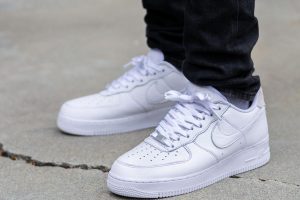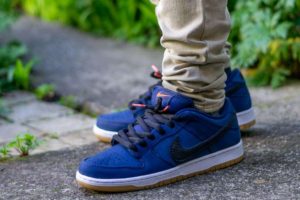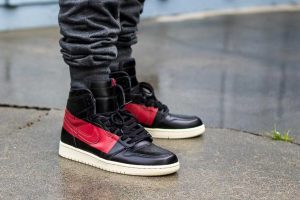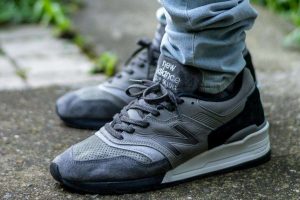In the realm of sneaker collecting, the term “buttery leather” gets thrown around a lot. I’ve noticed there’s some confusion as to what this means and/or implies.
Buttery Leather – Definition
The term “buttery leather” refers to leather with a soft, supple feel. This is independent of quality, texturing or grain.
As far as sneakers goes, collectors have been using the term “buttery” to describe leather for a long time. Sneakerheads desire a quality look and feel to their kicks and love a soft-feeling leather.
Certain categories of sneaker cater exclusively to this, such as the Air Force 1 Craft. Whereas regular Air Force 1s are popular, the Craft line capitalizes on a softer texture on the materials for the sneaker aficionado that likes their pairs to have a premium feel.
Smooth Vs Tumbled Leather
As far as buttery leather on sneakers goes, it doesn’t make a difference what finish is applied to the materials as long as they are soft. Tumbled leather might look better to some, but the term buttery only refers to the feel, not the look.
I’ve noticed that beginner sneaker collectors often focus on getting sneakers with tumbled leather. Tumbled leather often has a higher quality look to it. However on many sneakers the visible texturing is applied on as a finish, rather than a reflection of actual quality. You can see this on the swoosh on the Navy/Gum Orange Label SB Dunks for example.
I’ve had plenty of sneakers, particularly Nikes, where the finish looks great. Unfortunately, the actual texture when touched is often stiff and plasticky. This is the opposite of what you want when you’re looking for butter. Don’t let appearances fool you when it comes to how the sneakers actually feel.
In fact, stiff, plasticky leather is the typical archenemy of buttery soft leathers. While full grain leather is going to have some tumble to it and visible imperfections, mass-produced sneakers often just apply some full grain “texturing” to the materials to simulate quality. The truth comes out when you get the sneaker in hand and realize the leather is in fact nowhere close to full grain.
Why All Sneakers Aren’t Buttery
When it comes to sneaker fashion, many opt for a sneaker that “looks” premium vs one that feels soft to the touch. Sneaker companies of course cater to this by upgrading the look while saving money with a lower quality leather.
How To Tell If the Leather Is Buttery
It’s tough to tell how buttery the leather is on a shoe without holding it in your hands. If that’s not possible, some visual clues include an overly shiny or tumbled finish.
Shiny leather is usually bad news. An infamous example are the AJ1 Defiant Couture, which is supposed to evoke a “premium” look, but is comprised of shiny, plasticky leather.
A side consequence of hard, plastic-like leather is that it will crease instantaneously. While I’m not one to balk at creases that occur naturally, poor leather makes ugly creases fast when worn. This is unfair to the buyer considering how much these sneakers cost.
Why Buttery Leather Matters
While not a requirement for a good sneaker, soft materials evoke a more premium feel and a more comfortable fit. Stiff, rough materials often lead to a stiff, uncomfortable experience.
It’s common sense – stiff uppers lead to a stiff feel on foot. This is why so many Air Jordan retros feel uncomfortable and take a while to break in. By contrast, sneakers with a soft, supple upper are ready to go right out of the box with little break-in time.
Interestingly enough, many sneaker companies charge more for looks than quality! Whereas $100 will get you a stiff, shiny pair of basic quality Nike Dunks, sneakers like the adidas Forum 84 deliver twice the quality for the same price. In many cases, price is not an indicator as to how soft the leather will be on a sneaker. Some brands give you more bang for your buck!
All Sneakers Don’t Need To Be Buttery
For sneaker collectors, different sneakers have different qualities to them that make them worthwhile. Factors such as looks, cushioning, rarity and history among others may outweigh a soft feel to the materials.
I personally buy shoes for any number of reasons. Often, a soft buttery leather is a pleasant surprise, rather than something I sought out for that particular shoe.
When I’m buying a shoe for material quality, I’m expecting the sneaker to be nice and soft. For example, a pair of New Balance Made-line sneakers should have some soft leather.
On the other hand, I don’t have the same standard for other pairs such as Air Jordan retros. These pairs for me are more about the look, nostalgia and collectability as opposed to the actual feel of the leather.
So, if you really want that certain sneaker, don’t let a lack of buttery leather hold you back! While soft materials mean more comfort, less break-in, and a more quality “feel” to a shoe, it’s not the be-all end-all component of a fire pair. Rarity, looks, extras, storyline, cushioning and long-term comfort are all factors for the true sneaker collector.
Still, all things being equal, I’ll take a sneaker with buttery soft texture on the leather over a shiny, stiff, plastic-looking pair with an overtumbled finish. After my years of experience collecting sneakers, I can’t deny the feeling I get when I open up a box and the sneakers inside feel soft and supple right out of the gate!





